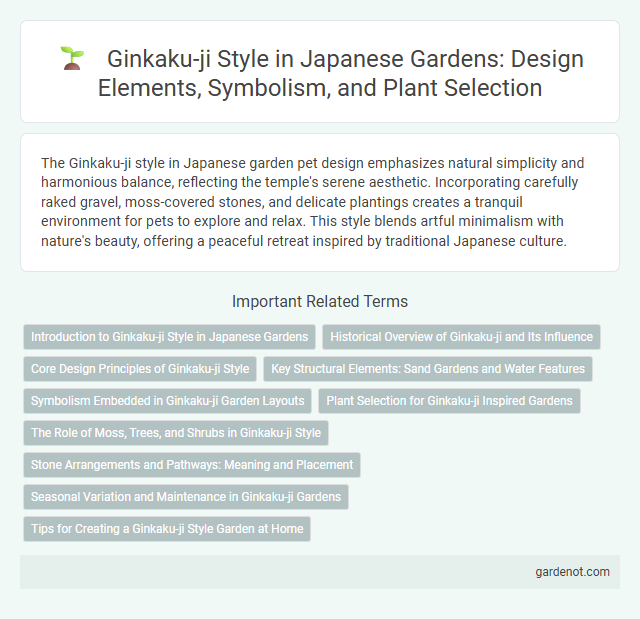The Ginkaku-ji style in Japanese garden pet design emphasizes natural simplicity and harmonious balance, reflecting the temple's serene aesthetic. Incorporating carefully raked gravel, moss-covered stones, and delicate plantings creates a tranquil environment for pets to explore and relax. This style blends artful minimalism with nature's beauty, offering a peaceful retreat inspired by traditional Japanese culture.
Introduction to Ginkaku-ji Style in Japanese Gardens
Ginkaku-ji style in Japanese gardens emphasizes simplicity, natural beauty, and subtle elegance, reflecting the principles of wabi-sabi and Zen Buddhism. Originating from the Ginkaku-ji temple in Kyoto, this design incorporates moss-covered grounds, carefully arranged rocks, and understated wooden architecture to evoke tranquility. The style prioritizes asymmetry and rustic textures to create a harmonious balance between nature and human artistry.
Historical Overview of Ginkaku-ji and Its Influence
Ginkaku-ji, also known as the Silver Pavilion, was established in 1482 by Ashikaga Yoshimasa during the Muromachi period, embodying the wabi-sabi aesthetic that emphasizes simplicity and imperfection. This Zen temple garden integrates dry landscape (karesansui) elements, moss gardens, and rustic architecture, profoundly influencing Japanese garden design by promoting serene contemplation and natural harmony. Its historical significance lies in shaping the Higashiyama culture, which has inspired countless gardens and traditional arts through the centuries.
Core Design Principles of Ginkaku-ji Style
The Ginkaku-ji style emphasizes simplicity, naturalness, and subtle elegance, reflecting the wabi-sabi aesthetic that values imperfection and transience. Core design principles include asymmetry, the use of natural materials like wood and stone, and the integration of the garden with surrounding landscapes to create a harmonious balance. Minimalist arrangements, moss-covered surfaces, and the purposeful placement of elements evoke a quiet, contemplative atmosphere central to the Ginkaku-ji approach.
Key Structural Elements: Sand Gardens and Water Features
Ginkaku-ji style gardens prominently feature meticulously raked sand gardens symbolizing flowing water or waves, designed to evoke tranquility and contemplation. Carefully arranged rocks within the sand create focal points that represent islands or mountains, enhancing the garden's symbolic landscape. Water features, including serene ponds and subtle streams, complement the sand gardens by adding movement and reflecting the surrounding natural beauty, integral to the Zen aesthetic.
Symbolism Embedded in Ginkaku-ji Garden Layouts
Ginkaku-ji garden layouts exemplify refined symbolism through the deliberate arrangement of rocks, water, and plants that represent the harmony between nature and Buddhist ideals. The Silver Pavilion itself embodies Zen principles, while the garden's asymmetrical design evokes the impermanence and simplicity central to wabi-sabi aesthetics. Each element, from the carefully raked gravel to the strategic placement of moss, conveys a deeper spiritual narrative reflecting mindfulness and tranquility.
Plant Selection for Ginkaku-ji Inspired Gardens
Ginkaku-ji-inspired gardens emphasize plant selections that reflect wabi-sabi aesthetics, prioritizing simplicity and natural beauty. Key plants include moss varieties like Hypnum and Dicranum, as well as Japanese maples (Acer palmatum) for their delicate foliage and seasonal color changes. Evergreen shrubs such as Camellia and azaleas provide year-round structure, while bamboo enhances the sense of tranquility and subtle movement.
The Role of Moss, Trees, and Shrubs in Ginkaku-ji Style
Moss in Ginkaku-ji style gardens creates a lush, serene ground cover that symbolizes age, stability, and natural beauty, enhancing the tranquil atmosphere. Carefully selected trees such as Japanese maples and pines provide structured focal points, their shapes reflecting wabi-sabi aesthetics and seasonal changes. Shrubs contribute to depth and texture, supporting the subtle layering that emphasizes simplicity and harmony with nature.
Stone Arrangements and Pathways: Meaning and Placement
Ginkaku-ji style stone arrangements emphasize asymmetry and naturalism, with carefully placed rocks symbolizing mountains and islands within the garden's miniature landscape. Pathways are designed to guide visitors through contemplative spaces, often using stepping stones of varying shapes and sizes to encourage mindfulness and a slow pace. The deliberate placement of stones and pathways reflects Zen principles, creating a harmonious balance between nature and human intervention.
Seasonal Variation and Maintenance in Ginkaku-ji Gardens
Ginkaku-ji gardens exhibit stunning seasonal variation with vibrant chrysanthemums in autumn and delicate cherry blossoms in spring enhancing the landscape's contemplative atmosphere. Meticulous maintenance includes regular pruning, raking of gravel patterns, and moss care to preserve the garden's aesthetic harmony and historical integrity. Skilled gardeners follow traditional techniques to sustain the balance between natural beauty and artistic design year-round.
Tips for Creating a Ginkaku-ji Style Garden at Home
Create a Ginkaku-ji style garden at home by incorporating simple, natural elements such as raked gravel, moss, and carefully placed stones to evoke the aesthetics of Wabi-sabi and Shibui. Utilize asymmetry and minimalism to achieve a tranquil atmosphere inspired by the Silver Pavilion in Kyoto, emphasizing quiet reflection and balance. Incorporate small water features or bamboo fences to enhance authenticity, along with native plants like Japanese maple or azalea to complete the serene landscape.
Ginkaku-ji style Infographic

 gardenot.com
gardenot.com